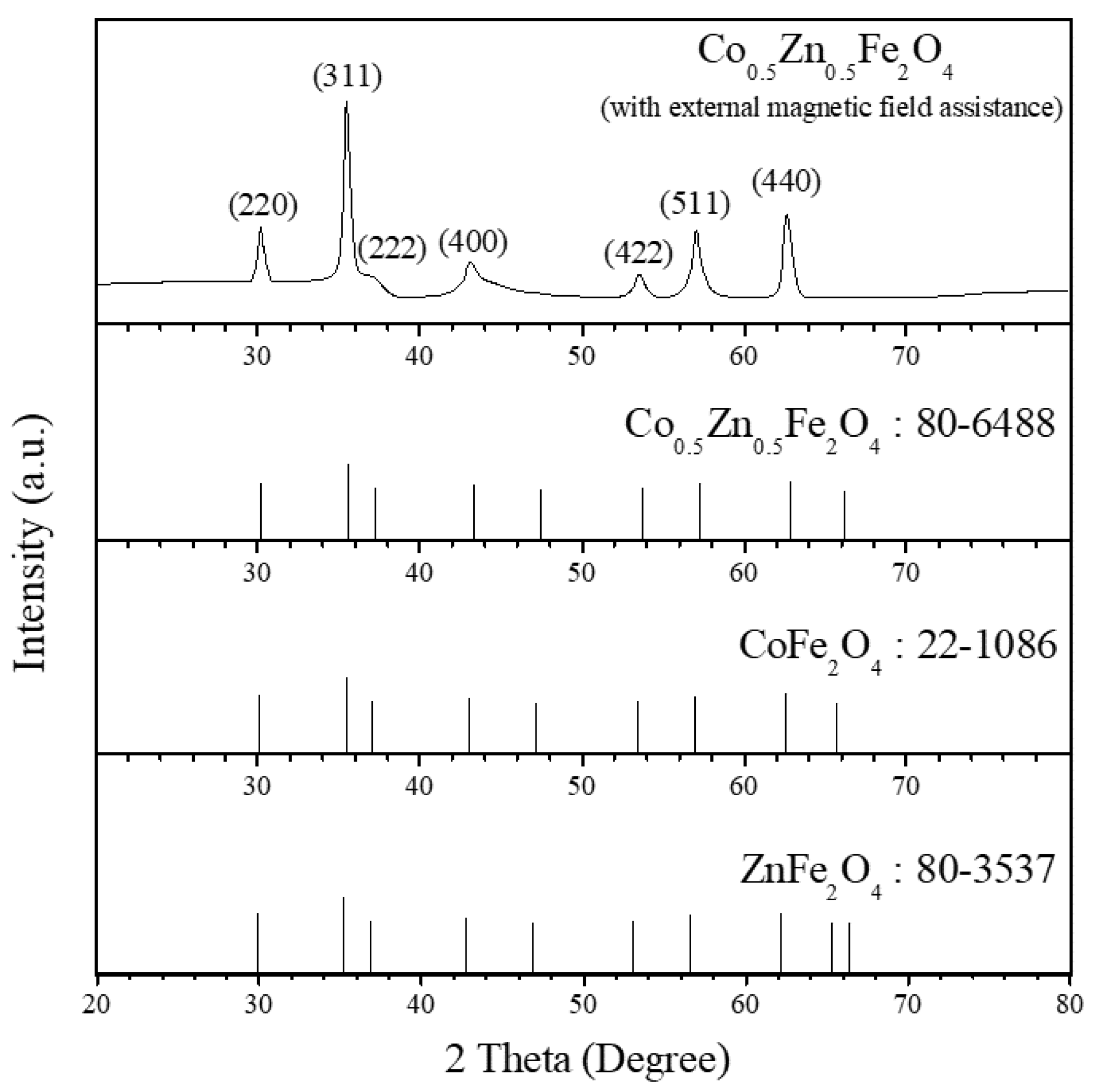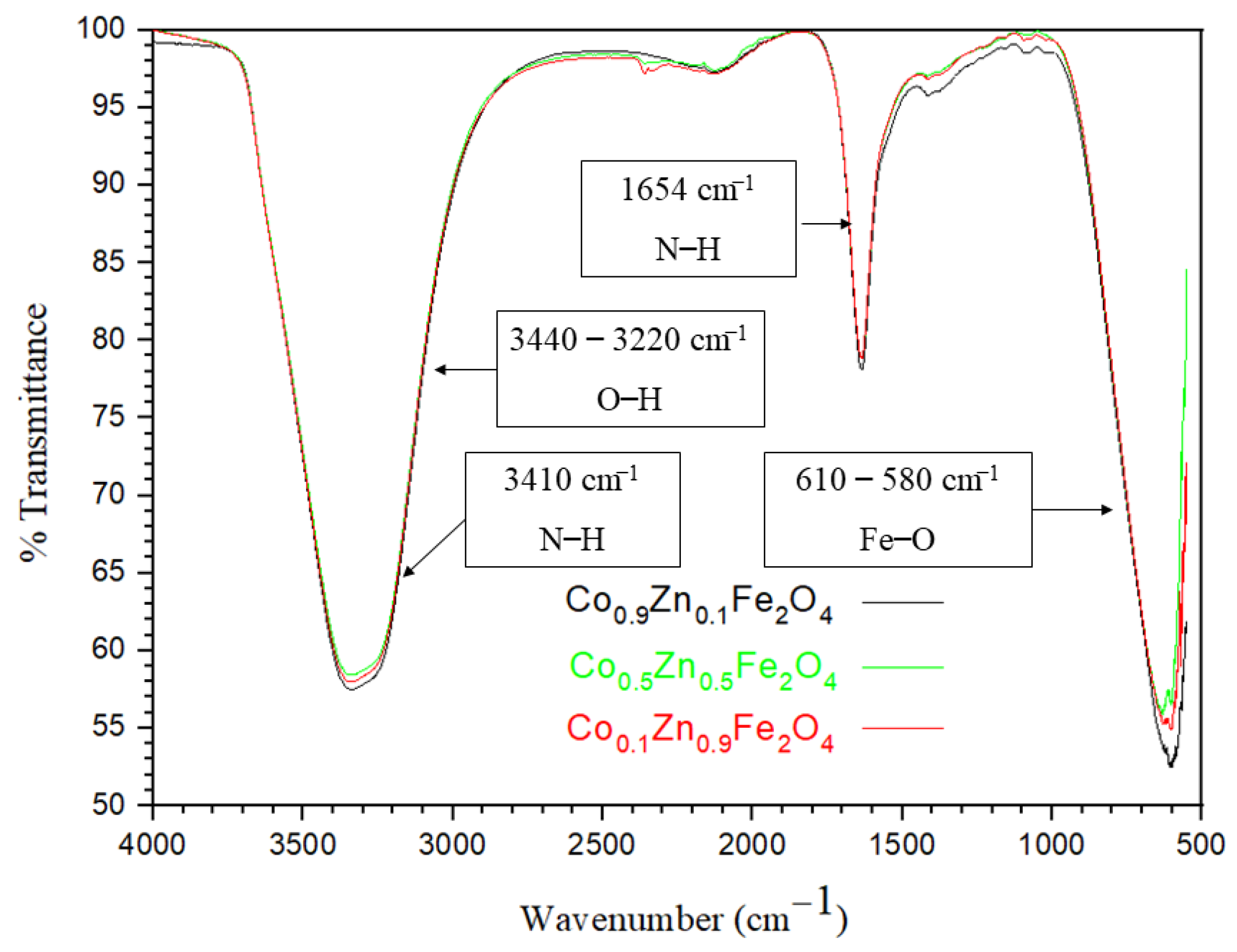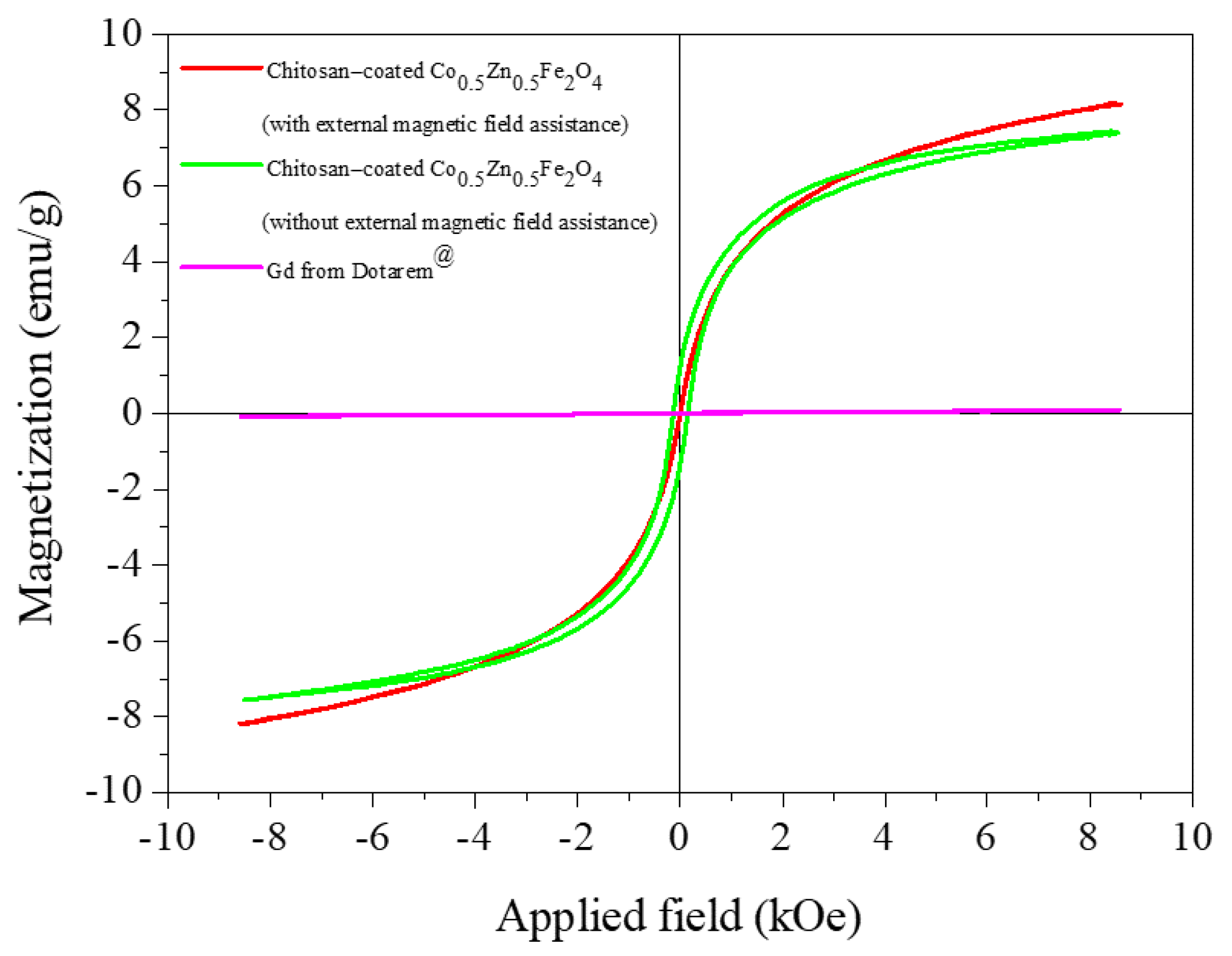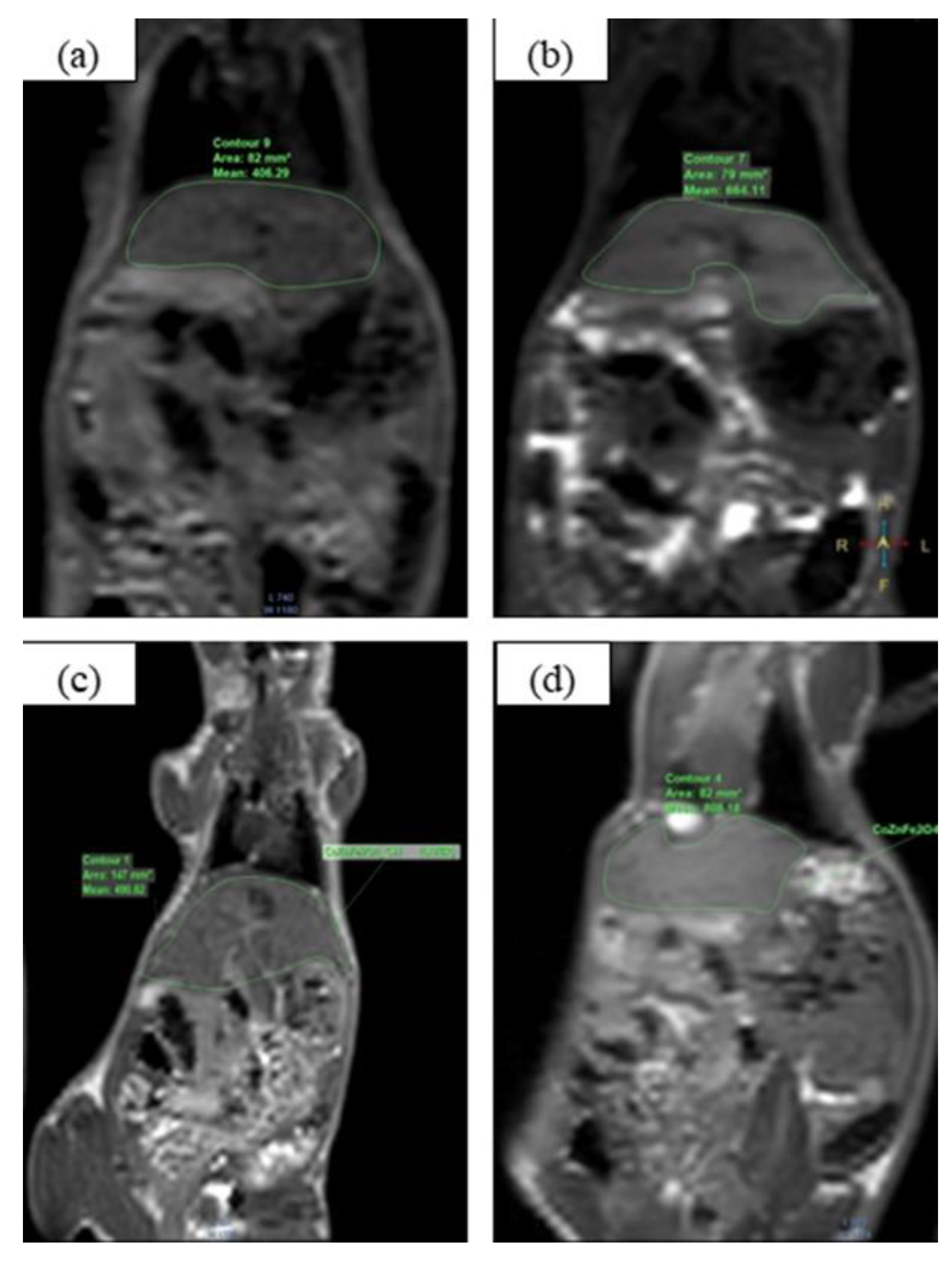Synthesis of Chitosan-Coated Co0.5Zn0.5Fe2O4 Nanoparticles for Contrast Enhancement in Magnetic Resonance Imaging
Abstract
:1. Introduction
2. Materials and Methods
2.1. Synthesis of Chitosan-Coated Co0.5Zn0.5Fe2O4
2.2. Characterization
2.3. Biocompatibility
2.4. Animal Testing
3. Results and Discussion
3.1. Material Characterization
3.2. Biocompatibility Study
3.3. MRI Application
4. Conclusions
Supplementary Materials
Author Contributions
Funding
Institutional Review Board Statement
Informed Consent Statement
Data Availability Statement
Conflicts of Interest
References
- Chan, M.H.; Li, C.H.; Chang, Y.C.; Hsiao, M. Iron-Based Ceramic Composite Nanomaterials for Magnetic Fluid Hyperthermia and Drug Delivery. Pharmaceutics 2022, 14, 2584. [Google Scholar] [CrossRef] [PubMed]
- Darwish, M.S.A.; Kim, H.; Lee, H.; Ryu, C.; Lee, J.Y.; Yoon, J. Engineering Core-Shell Structures of Magnetic Ferrite Nanoparticles for High Hyperthermia Performance. Nanomaterials 2020, 10, 991. [Google Scholar] [CrossRef]
- Nica, V.; Caro, C.; Páez-Muñoz, J.M.; Leal, M.P.; Garcia-Martin, M.L. Bi-Magnetic Core-Shell CoFe2O4@MnFe2O4 Nanoparticles for In Vivo Theranostics. Nanomaterials 2020, 10, 907. [Google Scholar] [CrossRef]
- Li, L.; Jiang, W.; Luo, K.; Song, H.; Lan, F.; Wu, Y.; Gu, Z. Superparamagnetic iron oxide nanoparticles as MRI contrast agents for non-invasive stem cell labeling and tracking. Theranostics 2013, 3, 595–615. [Google Scholar] [CrossRef]
- Bellin, M.F.; Van Der Molen, A.J. Extracellular gadolinium-based contrast media: An overview. Eur. J. Radiol. 2008, 66, 160–167. [Google Scholar] [CrossRef]
- Khan, S.; Hossain, M.K. Classification and properties of nanoparticles. In Nanoparticle-Based Polymer Composites; Woodhead Publishing: Sawston, UK, 2022; pp. 15–54. [Google Scholar] [CrossRef]
- Rubel, M.H.K.; Hossain, M.K. Chapter: 10 Crystal Structures and Properties of Nanomagnetic Materials, Fundamentals of Low Dimensional, 1st ed.; CRC Press: Boca Raton, FL, USA; Taylor & Francis Group: Abingdon, UK, 2022; pp. 183–205. [Google Scholar]
- Mozaffari, M.; Manouchehri, S.; Yousefi, M.H.; Amighian, J. The effect of solution temperature on crystallite size and magnetic properties of Zn substituted Co ferrite nanoparticles. J. Magn. Magn. Mater. 2010, 322, 383–388. [Google Scholar] [CrossRef]
- Sanpo, N.; Berndt, C.C.; Wen, C.; Wang, J. Transition metal-substituted cobalt ferrite nanoparticles for biomedical applications. J. Acta. Biomater. 2013, 9, 5830–5837. [Google Scholar] [CrossRef] [PubMed]
- He, H.Y.; Yan, Y.; Huang, J.F.; Lu, J. Rapid photodegradation of methyl blue on magnetic Zn1−xCoxFe2O4 nanoparticles synthesis by hydrothermal process. J. Sep. Purif. Technol. 2014, 136, 36–41. [Google Scholar] [CrossRef]
- Yadav, R.S.; Havlica, J.; Hnatko, M.; Šajgalík, P.; Alexander, C.; Palou, M.; Bartoníčková, E.; Boháč, M.; Frajkorová, F.; Masilko, J.; et al. Magnetic properties of Co1−xZnxFe2O4 spinel ferrite nanoparticles synthesized by starch-assisted sol-gel autocombustion method and its ball milling. J. Magn. Magn. Mater. 2015, 378, 190–199. [Google Scholar] [CrossRef]
- Samadia, M.S.; Shokrollahia, H.; Zamanianb, A. The magnetic-field-assisted synthesis of the Co-ferrite nanoparticles via reverse co-precipitation and their magnetic and structural properties. J. Mater. Chem. Phys. 2018, 215, 355–359. [Google Scholar] [CrossRef]
- Li, Y.; Hu, K.; Chen, B.; Liang, Y.; Fan, F.; Sun, J.; Zhang, Y.; Gu, N. Fe3O4@PSC nanoparticle clusters with enhanced magnetic properties prepared by alternating-current magnetic field assisted co-precipitation. Colloids Surf. A Physicochem. Eng. Asp. 2017, 520, 348–354. [Google Scholar] [CrossRef]
- Shibaev, A.V.; Shvets, P.V.; Kessel, D.E.; Kamyshinsky, R.A.; Orekhov, A.S.; Abramchuk, S.S.; Khokhlov, A.R.; Philippova, O.E. Magnetic-field-assisted synthesis of anisotropic iron oxide particles: Effect of pH. Beilstein J. Nanotechnol. 2020, 11, 1230–1241. [Google Scholar] [CrossRef]
- Jiang, C.; Leung, C.W.; Pong, P.W.T. Magnetic-Field-Assisted Assembly of Anisotropic Superstructures by Iron Oxide Nanoparticles and Their Enhanced Magnetism. Nanoscale Res. Lett. 2016, 11, 189. [Google Scholar] [CrossRef] [Green Version]
- Mohamed, W.S.; Alzaid, M.; Abdelbaky, M.S.M.; Amghouz, Z.; Granda, S.G.; Abu-Dief, A.M. Impact of Co2+ Substitution on Microstructure and Magnetic Properties of CoxZn1−xFe2O4 Nanoparticles. Nanomaterials 2019, 9, 1602. [Google Scholar] [CrossRef] [Green Version]
- Sattarahmady, N.; Zarea, T.; Mehdizadeh, A.R.; Azarpira, N.; Heidari, M.; Lotfi, M.; Heli, H. Dextrin-coated zinc substituted cobalt-ferrite nanoparticles as an MRI contrast agent: In vitro and in vivo imaging studies. Colloids Surf. B Biointerfaces 2015, 129, 15–20. [Google Scholar] [CrossRef]
- Ahmad, A.; Bae, H.; Kim, C.; Rhee, I. Characterization of zinc-doped cobalt ferrite nanoparticles for application as heat generators in magnetic hyperthermia and MRI contrast agents. J. Korean Phys. Soc. 2019, 74, 1151–1159. [Google Scholar] [CrossRef]
- Gözüak, F.; Köseoğlu, Y.; Baykal, A.; Kavas, H. Synthesis and characterization of CoxZn1−xFe2O4 magnetic nanoparticles via a PEG-assisted route. J. Magn. Magn. Mater. 2009, 321, 2170–2177. [Google Scholar] [CrossRef]
- Safari, R.; Hadi, H. Use of Dextran-Coated Cobalt–Zinc Ferrite Nanoparticles to Improve Image Quality in Magnetic Resonance Imaging: Non-Clinical Approach. Russ. J. Phys. Chem. A 2021, 95, 2643–2652. [Google Scholar] [CrossRef]
- Ansari, L.; Sharifi, I.; Ghadrijan, H.; Azarpira, N.; Momeni, F.; Zamani, H.; Rasouli, N.; Mohammadi, M.; Mehdizadeh, A.; Abedi-Firouzjah, R. Synthesis, Characterization and MRI Application of Cobalt-Zinc Ferrite Nanoparticles Coated with DMSA: An In-vivo Study. Appl. Magn. Reson. 2021, 52, 33–45. [Google Scholar] [CrossRef]
- Hossain, M.K.; Khan, M.I.; El-Denglawey, A. A review on biomedical applications, prospects, and challenges of rare earth oxides. Appl. Mater. Today 2021, 24, 101104. [Google Scholar] [CrossRef]
- Hoque, M.D.A.; Ahmed, M.R.; Rahman, G.T.; Rahman, M.T.; Islam, M.A.; Khan, M.A.; Hossain, M.K. Fabrication and comparative study of magnetic Fe and α-Fe2O3 nanoparticles dispersed hybrid polymer (PVA+Chitosan) novel nanocomposite film. Results Phys. 2018, 10, 434–443. [Google Scholar] [CrossRef]
- Anik, M.I.; Hossain, M.K.; Hossain, I.; Ahmed, I.; Doha, R.M. Biomedical applications of magnetic nanoparticles. In Magnetic Nanoparticle-Based Hybrid Materials; Woodhead Publishing: Sawston, UK, 2021; pp. 463–497. [Google Scholar] [CrossRef]
- Indla, S.; Chelvane, A.; Lodh, A.; Das, D. Enhancement in magnetostrictive properties of cobalt ferrite by magnetic field assisted compaction technique. J. Alloys Comp. 2019, 779, 886–891. [Google Scholar] [CrossRef]
- Coppola, P.; da Silva, F.G.; Gomide, G.; Paula, F.L.O.; Campos, A.F.C.; Perzynski, R.; Kern, C.; Depeyrot, J.; Aquino, R. Hydrothermal Synthesis of Mixed Zinc–Cobalt Ferrite Nanoparticles: Structural and Magnetic Properties. J. Nanoparticle Res. 2016, 18, 138. [Google Scholar] [CrossRef]
- Sundararajan, M.; Kennedy, L.J.; Aruldoss, U.; Pasha, S.k.K.; Vijaya, J.J.; Dunn, S. Microwave combustion synthesis of zinc substituted nanocrystalline spinel cobalt ferrite: Structural and magnetic studies. J. Mat. Sci. Semicon. Proc. 2015, 40, 1–10. [Google Scholar] [CrossRef]
- Yadav, R.S.; Kuřitka, I.; Havlica, J.; Hnatko, M.; Alexander, C.; Masilko, J.; Kalina, L.; Hajdúchová, M.; Rusnak, J.; Enev, V. Structural, magnetic, elastic, dielectric and electrical properties of hotpress sintered Co1−xZnxFe2O4 (x = 0.0, 0.5) spinel ferrite nanoparticles. J. Magn. Magn. Mater. 2018, 447, 48–57. [Google Scholar] [CrossRef]
- Shen, M.; Yu, Y.; Fan, G.; Chen, G.; Jin, Y.M.; Tang, W.; Jia, W. The synthesis and characterization of monodispersed chitosan-coated Fe3O4 nanoparticles via a facile one-step solvothermal process for adsorption of bovine serum albumin. Nanoscale Res. Lett. 2014, 9, 296. [Google Scholar] [CrossRef] [Green Version]
- Sanpo, N.; Tharajak, J.; Li, Y.; Berndt, C.C.; Wen, C.; Wang, J. Biocompatibility of transition metal-substituted cobalt ferrite nanoparticles. J. Nanoparticle Res. 2014, 16, 2510. [Google Scholar] [CrossRef]
- Chunpenmongkol, S.; Wantanajittikul, K.; Rerkasem, K.; Ya-in, C.; Saekho, S. Classification of carotid atherosclerotic plaque components using T2 mapping technique from magnetic resonance imaging. J. Assoc. Med. Sci. 2014, 47, 37–44. Available online: https://he01.tci-thaijo.org/index.php/bulletinAMS/article/view/59987 (accessed on 27 March 2021).
- Xiao, Y.D.; Paudel, R.; Liu, J.; Ma, C.; Zhang, Z.S.; Zhou, S.K. MRI contrast agents: Classification and application (review). Int. J. Mol. Med. 2016, 38, 1319–1326. [Google Scholar] [CrossRef] [Green Version]
- Israel, L.L.; Galstyan, A.; Holle, E.; Ljubimova, J.Y. Magnetic iron oxide nanoparticles for imaging, targeting and treatment of primary and metastatic tumors of the brain. J. Control Release 2020, 320, 45–62. [Google Scholar] [CrossRef]
- Junior, J.E.; Santos, A.C.D.; Koenigkam-Santos, M.; Nogueira-Barbosa, M.H.; Muglia, V.F. Complications from the use of intravenous gadoliniumbased contrast agents for magnetic resonance imaging. Radiol. Bras. 2008, 4, 263–267. [Google Scholar] [CrossRef] [Green Version]
- Yang, C.T.; Chandrasekharan, P.; He, T.; Poh, Z.; Raju, A.; Chuang, K.H.; Robins, E.G. An intravascular MRI contrast agent based on Gd (DO3A-Lys) for tumor angiography. Biomaterials 2014, 35, 327–336. [Google Scholar] [CrossRef] [PubMed]
- Novotna, B.; Herynek, V.; Rossner Jr, P.; Turnovcova, K.; Jendelova, P. The effects of grafted mesenchymal stem cells labeled with iron oxide or cobalt-zinc-iron nanoparticles on the biological macromolecules of rat brain tissue extracts. Int. J. Nanomed. 2017, 12, 4519–4526. [Google Scholar] [CrossRef] [PubMed] [Green Version]
- Ghasemian, Z.; Shahbazi-Gahrouei, D.; Manouchehri, S. Cobalt zinc ferrite nanoparticles as a potential magnetic resonance imaging agent: An in vitro study. Avicenna J. Med. Biotechnol. 2015, 7, 64–68. Available online: https://www.ncbi.nlm.nih.gov/pmc/articles/PMC4483316/ (accessed on 1 December 2022).
- Elster, A.D.; Burdette, J.H. Chapter 3—Image contrast. In Questions and Answers in Magnetic Resonance Imaging, 2nd ed.; Mosby: St. Louis, MO, USA, 2001; p. 1272. [Google Scholar]








| Synthesis | Method | Particle Sizes (nm) | Magnetic Properties | Applications | Ref. |
|---|---|---|---|---|---|
| Dextrin-coated Co0.5Zn0.5Fe2O4 | Co- precipitation | 3.9 | Superparamagnetic | MRI contrast agent | [17] |
| Silica-coated Co0.6Zn0.4Fe2O4 | Hydrothermal technique | 90 | Superparamagnetic | MRI contrast agent and magnetic hyperthermia | [18] |
| Dextran-coated Co0.8Zn0.2Fe2O4 | Heat treatment method | 34 | Superpara-magnetic | MRI contrast agent | [20] |
| DMSA-coated Co0.6Zn0.4Fe2O4 | Thermal decomposition method | 8 | Superpara-magnetic | MRI contrast agent | [21] |
Disclaimer/Publisher’s Note: The statements, opinions and data contained in all publications are solely those of the individual author(s) and contributor(s) and not of MDPI and/or the editor(s). MDPI and/or the editor(s) disclaim responsibility for any injury to people or property resulting from any ideas, methods, instructions or products referred to in the content. |
© 2023 by the authors. Licensee MDPI, Basel, Switzerland. This article is an open access article distributed under the terms and conditions of the Creative Commons Attribution (CC BY) license (https://creativecommons.org/licenses/by/4.0/).
Share and Cite
Worawong, A.; Onreabroy, W. Synthesis of Chitosan-Coated Co0.5Zn0.5Fe2O4 Nanoparticles for Contrast Enhancement in Magnetic Resonance Imaging. Coatings 2023, 13, 276. https://doi.org/10.3390/coatings13020276
Worawong A, Onreabroy W. Synthesis of Chitosan-Coated Co0.5Zn0.5Fe2O4 Nanoparticles for Contrast Enhancement in Magnetic Resonance Imaging. Coatings. 2023; 13(2):276. https://doi.org/10.3390/coatings13020276
Chicago/Turabian StyleWorawong, Apichaya, and Wandee Onreabroy. 2023. "Synthesis of Chitosan-Coated Co0.5Zn0.5Fe2O4 Nanoparticles for Contrast Enhancement in Magnetic Resonance Imaging" Coatings 13, no. 2: 276. https://doi.org/10.3390/coatings13020276





